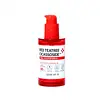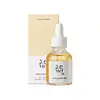What's inside
What's inside
 Key Ingredients
Key Ingredients

 Benefits
Benefits

 Concerns
Concerns

 Ingredients Side-by-side
Ingredients Side-by-side

Melaleuca Alternifolia Leaf Extract
PerfumingButylene Glycol
HumectantPropanediol
Solvent1,2-Hexanediol
Skin ConditioningNiacinamide
SmoothingWater
Skin ConditioningPolyglyceryl-10 Laurate
Skin ConditioningCarbomer
Emulsion StabilisingArginine
MaskingGlycerin
HumectantEclipta Prostrata Extract
Skin ConditioningCoccinia Indica Fruit Extract
Skin ConditioningEthylhexylglycerin
Skin ConditioningCellulose Gum
Emulsion StabilisingAdenosine
Skin ConditioningCamellia Sinensis Leaf Extract
AntimicrobialMelaleuca Alternifolia Leaf Oil
AntioxidantGlycyrrhiza Glabra Root Extract
BleachingAgrimonia Eupatoria Extract
AstringentDisodium EDTA
Perilla Frutescens Leaf Extract
MaskingLactobionic Acid
BufferingSilybum Marianum Seed Extract
Skin ConditioningBeta-Glucan
Skin ConditioningBroussonetia Kazinoki Root Extract
Skin ConditioningPropolis Extract
Skin ConditioningCimicifuga Dahurica Root Extract
AntioxidantSalix Alba Bark Extract
AstringentPentylene Glycol
Skin ConditioningOenothera Biennis Flower Extract
AstringentMadecassoside
AntioxidantCitric Acid
BufferingSodium Carbomer
Emulsion StabilisingPolyacrylate Crosspolymer-6
Emulsion StabilisingT-Butyl Alcohol
PerfumingHydroxycinnamic Acid
Skin ConditioningRutin
AntioxidantMelaleuca Alternifolia Leaf Extract, Butylene Glycol, Propanediol, 1,2-Hexanediol, Niacinamide, Water, Polyglyceryl-10 Laurate, Carbomer, Arginine, Glycerin, Eclipta Prostrata Extract, Coccinia Indica Fruit Extract, Ethylhexylglycerin, Cellulose Gum, Adenosine, Camellia Sinensis Leaf Extract, Melaleuca Alternifolia Leaf Oil, Glycyrrhiza Glabra Root Extract, Agrimonia Eupatoria Extract, Disodium EDTA, Perilla Frutescens Leaf Extract, Lactobionic Acid, Silybum Marianum Seed Extract, Beta-Glucan, Broussonetia Kazinoki Root Extract, Propolis Extract, Cimicifuga Dahurica Root Extract, Salix Alba Bark Extract, Pentylene Glycol, Oenothera Biennis Flower Extract, Madecassoside, Citric Acid, Sodium Carbomer, Polyacrylate Crosspolymer-6, T-Butyl Alcohol, Hydroxycinnamic Acid, Rutin
Propolis Extract
Skin ConditioningDipropylene Glycol
HumectantGlycerin
HumectantButylene Glycol
HumectantWater
Skin ConditioningNiacinamide
Smoothing1,2-Hexanediol
Skin ConditioningMelia Azadirachta Flower Extract
Skin ConditioningMelia Azadirachta Leaf Extract
Skin ConditioningSodium Hyaluronate
HumectantCurcuma Longa Root Extract
MaskingOcimum Sanctum Leaf Extract
Skin ConditioningTheobroma Cacao Seed Extract
AntioxidantMelaleuca Alternifolia Leaf Extract
PerfumingCentella Asiatica Extract
CleansingCorallina Officinalis Extract
Skin ConditioningLotus Corniculatus Seed Extract
Skin ConditioningCalophyllum Inophyllum Seed Oil
AntimicrobialBetaine Salicylate
AntimicrobialSodium Polyacryloyldimethyl Taurate
Emulsion StabilisingTromethamine
BufferingPolyglyceryl-10 Laurate
Skin ConditioningCaprylyl Glycol
EmollientEthylhexylglycerin
Skin ConditioningDextrin
AbsorbentPentylene Glycol
Skin ConditioningOctanediol
Tocopherol
AntioxidantXanthan Gum
EmulsifyingCarbomer
Emulsion StabilisingPropolis Extract, Dipropylene Glycol, Glycerin, Butylene Glycol, Water, Niacinamide, 1,2-Hexanediol, Melia Azadirachta Flower Extract, Melia Azadirachta Leaf Extract, Sodium Hyaluronate, Curcuma Longa Root Extract, Ocimum Sanctum Leaf Extract, Theobroma Cacao Seed Extract, Melaleuca Alternifolia Leaf Extract, Centella Asiatica Extract, Corallina Officinalis Extract, Lotus Corniculatus Seed Extract, Calophyllum Inophyllum Seed Oil, Betaine Salicylate, Sodium Polyacryloyldimethyl Taurate, Tromethamine, Polyglyceryl-10 Laurate, Caprylyl Glycol, Ethylhexylglycerin, Dextrin, Pentylene Glycol, Octanediol, Tocopherol, Xanthan Gum, Carbomer
 Reviews
Reviews

Ingredients Explained
These ingredients are found in both products.
Ingredients higher up in an ingredient list are typically present in a larger amount.
1,2-Hexanediol is a synthetic liquid and another multi-functional powerhouse.
It is a:
- Humectant, drawing moisture into the skin
- Emollient, helping to soften skin
- Solvent, dispersing and stabilizing formulas
- Preservative booster, enhancing the antimicrobial activity of other preservatives
Butylene Glycol (or BG) is used within cosmetic products for a few different reasons:
Overall, Butylene Glycol is a safe and well-rounded ingredient that works well with other ingredients.
Though this ingredient works well with most skin types, some people with sensitive skin may experience a reaction such as allergic rashes, closed comedones, or itchiness.
Learn more about Butylene GlycolCarbomer is a polymer of acrylic acid. Its main role is to create a gel consistency.
A high amount of carbomer can cause pilling or balling up of products. Don't worry, most products contain 1% or less of carbomer.
Ethylhexylglycerin (we can't pronounce this either) is commonly used as a preservative and skin softener. It is derived from glyceryl.
You might see Ethylhexylglycerin often paired with other preservatives such as phenoxyethanol. Ethylhexylglycerin has been found to increase the effectiveness of these other preservatives.
Glycerin is already naturally found in your skin. It helps moisturize and protect your skin.
A study from 2016 found glycerin to be more effective as a humectant than AHAs and hyaluronic acid.
As a humectant, it helps the skin stay hydrated by pulling moisture to your skin. The low molecular weight of glycerin allows it to pull moisture into the deeper layers of your skin.
Hydrated skin improves your skin barrier; Your skin barrier helps protect against irritants and bacteria.
Glycerin has also been found to have antimicrobial and antiviral properties. Due to these properties, glycerin is often used in wound and burn treatments.
In cosmetics, glycerin is usually derived from plants such as soybean or palm. However, it can also be sourced from animals, such as tallow or animal fat.
This ingredient is organic, colorless, odorless, and non-toxic.
Glycerin is the name for this ingredient in American English. British English uses Glycerol/Glycerine.
Learn more about GlycerinMelaleuca Alternifolia Leaf Extract comes from the Tea Tree, Melaleuca alternifolia, Myrtaceae. This tea tree is native to Australia.
Tea Leaf extract contains antimicrobial and anti-acne properties.
This ingredient has perfuming properties and contains linalool and limonene. These fragrance and terpinen components can cause skin sensitivity.
Learn more about the benefits of Tea Tree Oil here.
Learn more about Melaleuca Alternifolia Leaf ExtractNiacinamide is a multitasking form of vitamin B3 that strengthens the skin barrier, reduces pores and dark spots, regulates oil, and improves signs of aging.
And the best part? It's gentle and well-tolerated by most skin types, including sensitive and reactive skin.
You might have heard of "niacin flush", or the reddening of skin that causes itchiness. Niacinamide has not been found to cause this.
In very rare cases, some individuals may not be able to tolerate niacinamide at all or experience an allergic reaction to it.
If you are experiencing flaking, irritation, and dryness with this ingredient, be sure to double check all your products as this ingredient can be found in all categories of skincare.
When incorporating niacinamide into your routine, look out for concentration amounts. Typically, 5% niacinamide provides benefits such as fading dark spots. However, if you have sensitive skin, it is better to begin with a smaller concentration.
When you apply niacinamide to your skin, your body converts it into nicotinamide adenine dinucleotide (NAD). NAD is an essential coenzyme that is already found in your cells as "fuel" and powers countless biological processes.
In your skin, NAD helps repair cell damage, produce new healthy cells, support collagen production, strengthen the skin barrier, and fight environmental stressors (like UV and pollution).
Our natural NAD levels start to decline with age, leading to slower skin repair, visible aging, and a weaker skin barrier. By providing your skin niacinamide, you're recharging your skin's NAD levels. This leads to stronger, healthier, and younger looking skin.
Another name for vitamin B3 is nicotinamide. This vitamin is water-soluble and our bodies don't store it. We obtain Vitamin B3 from either food or skincare. Meat, fish, wheat, yeast, and leafy greens contain vitamin B3.
The type of niacinamide used in skincare is synthetically created.
Learn more about NiacinamidePentylene glycol is typically used within a product to thicken it. It also adds a smooth, soft, and moisturizing feel to the product. It is naturally found in plants such as sugar beets.
The hydrophilic trait of Pentylene Glycol makes it a humectant. As a humectant, Pentylene Glycol helps draw moisture from the air to your skin. This can help keep your skin hydrated.
This property also makes Pentylene Glycol a great texture enhancer. It can also help thicken or stabilize a product.
Pentylene Glycol also acts as a mild preservative and helps to keep a product microbe-free.
Some people may experience mild eye and skin irritation from Pentylene Glycol. We always recommend speaking with a professional about using this ingredient in your routine.
Pentylene Glycol has a low molecular weight and is part of the 1,2-glycol family.
Learn more about Pentylene GlycolPolyglyceryl-10 Laurate is an ester of lauric acid and Polyglycerin-10.
Polyglyceryl-10 Laurate is a cleansing agent and emulsifier. It helps gather dirt, oil, and other pollutants to be rinsed away. As an emulsifier, it helps prevent ingredients from separating, such as oil and water.
Polyglyceryl-10 Laurate may not be fungal acne safe.
Learn more about Polyglyceryl-10 LauratePropolis Extract is also known as bee glue.
This ingredient has antimicrobial, anti-inflammatory, wound healing, and antioxidant properties.
Studies show propolis helps fight against bacteria, viruses, and fungi. This may help with reducing acne and accelerate wound healing.
The flavonoids found in propolis extract are potent antioxidants. Antioxidants may help with reducing the signs of aging.
A study from 2020 found propolis to help reverse skin damage from UV.
Fun facts: This ingredient is created by mixing beeswax, bee saliva, and parts of trees. Bees use propolis as a sealant to close any gaps in their hives.
Since it is an animal-derived product, this ingredient is not considered vegan. For vegan alternatives, check out Galactomyces Ferment Filtrate or Centella Asiatica Extract.
Learn more about Propolis ExtractWater. It's the most common cosmetic ingredient of all. You'll usually see it at the top of ingredient lists, meaning that it makes up the largest part of the product.
So why is it so popular? Water most often acts as a solvent - this means that it helps dissolve other ingredients into the formulation.
You'll also recognize water as that liquid we all need to stay alive. If you see this, drink a glass of water. Stay hydrated!
Learn more about Water